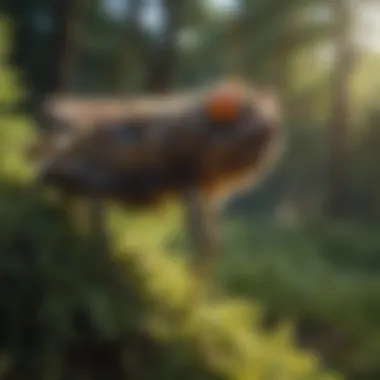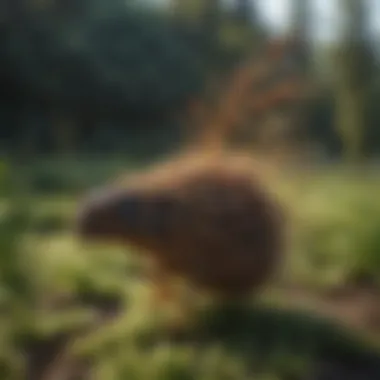Effective Strategies to Eliminate Bagworms


Overview of the Topic
Definition and Importance
Bagworms are caterpillars of the moth species known as Thyridopteryx ephemeraeformis. They are significant pests in horticulture and agriculture due to their tendency to feed on the foliage of various plants, trees, and shrubs. An infestation can result in noticeable defoliation and stress on the plant, eventually leading to its demise if not adequately controlled. Understanding the nature of bagworms is crucial for gardening enthusiasts and agricultural professionals, especially to maintain healthy and thriving crops.
Current Trends
Recent research indicates an increasing prevalence of bagworm infestations, influenced by climatic changes and variations in land management practices. Agriculture farmers are now focusing on integrated pest management, often combining chemical and organic methods. Sustainable practices are gaining traction as advocates prioritize the health of ecosystems alongside crop yield. Such trends indicate a growing awareness around the ecological impacts of traditional pest control methods.
Key Techniques and Practices
Step-by-Step Guide
- Identification: Recognizing bagworms early in their lifecycle is vital. Look for the characteristic silk bags they construct, often dangling from branches. These bags are brown and resemble small, dried leaves.
- Monitoring: Consistently inspect plants, particularly during the spring and summer months when bagworms are most active. Check the underside of leaves and branches for eggs and early larvae.
- Manual Removal: For small infestations, physically removing the bags can be effective. Simply cut them off and dispose of them properly.
- Biological Control: Introducing natural predators like birds and beneficial insects can manage bagworm populations. Ladybugs and lacewings are known to feed on these pests.
- Chemical Treatments: When infestations are extensive, chemical solutions may be necessary. Products containing Bacillus thuringiensis (Bt) are effective against young larvae. Apply treatments in accordance with the manufacturer's instructions for safety and effectiveness.
- Cultural Practices: Promote healthy plant growth by ensuring adequate water, nutrients, and sunlight. A robust plant is less susceptible to pests, including bagworms.
Tools and Equipment Needed
- Gloves: For manual removal and handling of chemicals.
- Pruning Shears: For cutting off infested branches or bags.
- Sprayers: For applying liquid treatments to affected areas.
- Monitoring Kits: Useful for tracking pest populations and their life cycle stages.
Challenges and Solutions
Common Obstacles
Bagworms can adapt to various environments, making them difficult to eradicate completely. Some of the challenges include identifying the early stages of infestation and variations in plant species' susceptibility.
Innovative Solutions
- Education: Continuous learning about bagworm life cycles and their ecological role can empower farmers to make informed decisions on management techniques.
- Technology: Utilizing apps and pest identification tools can aid in early detection. For instance, programs available on web platforms like Reddit or Facebook can connect farmers to share experiences and solutions regarding pest management.
"Integrating knowledge and modern technology can significantly enhance the effectiveness of pest management strategies."
Maintaining an awareness of the life cycles and habits of bagworms is essential in addressing infestations efficiently and sustainably. Implementing these strategies will equip agricultural professionals and enthusiasts to protect their plants effectively.
Understanding Bagworms
The comprehension of bagworms serves as a foundation for effective pest management in agriculture. Knowing their characteristics and life cycle helps in implementing strategies to combat them effectively. Ignorance about bagworms can lead to severe infestations that jeopardize plant health and crop yields.
Defining Bagworms
Bagworms are the larval stage of moths in the family Psychidae. They create protective silk and plant material bags that they carry while feeding on host plants. This unique behavior allows them to blend into their surroundings and evade many predators. Recognizing this definition is crucial for anyone invested in plant protection, as it highlights the need for careful monitoring and identification to prevent extensive damage to foliage.
Life Cycle and Development
The life cycle of bagworms demonstrates their resilience and adaptability. Understanding these stages aids in pinpointing the best times for intervention.
Egg Stage
During the egg stage, bagworms are in the form of small eggs, typically laid in silk bags attached to twigs or branches. This initial phase is significant because it marks the beginning of the infestation cycle. The eggs are often protected from environmental extremes and predators, making them a formidable starting point for future populations. Recognizing egg presence early can initiate timely control measures before they develop into more damaging stages.
Lava Stage
In the lava stage, the young caterpillars emerge to feed on plants. This phase is critical since the larvae are responsible for the most visible damage to host plants through their feeding habits. They construct their cases using bits of leaves and twigs, which provides them camouflage against predation. Their voracious nature means that they can quickly defoliate sections of plants, making this stage essential to target for effective management strategies.
Pupal Stage
The pupal stage occurs when the larvae enter a phase of transformation. They typically remain in their protective bags during this time. This stage is vital as the pupae are transitioning into adults. While they may not feed during this time, identifying the presence of pupae suggests that an increase in the adult population is imminent. Recognizing this stage can help in preparing for effective control measures before their emergence.
Adult Stage


Finally, the adult stage involves the emergence of moths from their pupal cases. These adults are less harmful compared to the larvae and mainly focus on reproduction. However, understanding their pattern of emergence assists in determining optimal times for control methods targeting earlier life stages. Acknowledging the adult stage can also aid in implementing integrated pest management practices that consider all phases of their life cycle.
Habitat and Host Plants
Gaining insight into the preferred habitats and host plants of bagworms is essential to understanding their distribution and potential impact on agricultural practices.
Preferred Environments
Bagworms thrive in various habitats, particularly in areas with ample vegetation. They are often found in gardens, forests, and landscapes with high leaf density. This adaptability allows them to survive in numerous environments, presenting a challenge for management. Knowledge of these environments aids in planning prevention strategies.
Common Host Plants
Certain plants are more susceptible to bagworm infestations than others. Common host plants include spruce, cedar, and various hardwood trees. These plants provide both food and suitable attachment sites for bagworm eggs and cases. Identifying which plants are most at risk allows for targeted management efforts to protect valuable crops and ornamentals from damage.
Identifying Bagworm Damage
Identifying bagworm damage is crucial for effective control and eradication strategies. Early detection of their presence allows for timely intervention, minimizing potential harm to plants. Understanding the signs of infestation is essential for agricultural professionals and enthusiasts alike. This knowledge helps in developing targeted solutions and preserving the health of gardens and landscapes.
Visual Signs of Infestation
Recognizing visual signs of bagworm infestation can facilitate early diagnosis and treatment. There are two primary signs to look out for: caterpillar bags and defoliation patterns.
Caterpillar Bags
Caterpillar bags are one of the most noticeable signs of bagworm presence. These silk and plant material constructions house the larvae and serve as both shelter and camouflage. The key characteristic of caterpillar bags is their appearance. They often resemble small, hanging bags that can vary in size, depending on the stage of the larvae. Their unique feature is also the way they blend in with the surrounding foliage, making them hard to spot until infestations escalate. The visibility of these bags makes them a useful indicator for gardeners, as spotting them can lead to swift action. However, the primary disadvantage is that they can go unnoticed in dense vegetation, which can delay action against an infestation.
Defoliation Patterns
Defoliation patterns provide another critical clue to identifying bagworm damage. When bagworms feed on plant leaves, they often create irregular patterns of defoliation. The key characteristic here is that affected plants will show signs of significant leaf loss, especially at the terminal ends of branches. This can be alarming for gardeners as rapid defoliation can diminish a plant’s health and vigor. Recognizing these patterns is beneficial because it indicates the level of feeding pressure from bagworms. The unique feature of defoliation patterns is their ability to reveal the severity of the infestation. However, it can also complicate the monitoring process since defoliation can result from other pests or environmental stressors. Therefore, discerning its cause requires careful observation of additional signs.
Assessing Severity of Damage
Once bagworm damage is identified, assessing its severity becomes imperative. This evaluation plays a pivotal role in shaping the response strategies for control.
Impact on Plant Health
The impact on plant health is immediate and visible. Heavy infestations can lead to significant stress on host plants, often resulting in stunted growth or even death in extreme cases. The key characteristic of this impact is that it reduces a plant's ability to photosynthesize effectively, leading to weakening over time. Recognizing the impact on plant health is beneficial because it informs appropriate intervention methods. The distinct feature here is that once health is compromised, restoring it requires considerable effort and time. Therefore, timely assessment aids in minimizing those impacts and sustaining plant health in the long run.
Long-Term Consequences
Long-term consequences of bagworm damage can be severe, impacting not only individual plants but entire ecosystems. A key characteristic of these consequences is decreased biodiversity. If left unchecked, infestations can lead to plant loss, which reduces habitat for other species. Understanding long-term consequences is crucial for making informed decisions about pest management. The unique feature of these consequences is their profound influence on future growth cycles of affected plants. It can take years for plants to rebound after severe infestations. Therefore, foresight in assessing damage helps in planning preventative measures for the future.
"Timely identification and assessment of bagworm damage is vital for maintaining healthy plant ecosystems and ensuring effective pest control strategies."
In summary, identifying bagworm damage is essential for effective management. Understanding the signs and assessing the severity contribute to timely and targeted actions, safeguarding plants from extensive harm.
Prevention Strategies
The importance of prevention strategies in the fight against bagworms cannot be overstated. Prevention is often more effective and less costly than dealing with an established infestation. Implementing these practices can reduce the risk of bagworm damage significantly, making them essential for maintaining plant health. Effective prevention not only protects individual plants but also supports the overall ecosystem, minimizing the reliance on chemical treatments.
Cultural Practices
Sanitation Methods
Sanitation methods involve maintaining a clean garden or landscape to minimize bagworm populations. This includes the removal of fallen leaves, debris, and any infected plant materials. The key characteristic of sanitation methods is their proactive approach, preventing pests from taking root.
Using sanitation methods is a beneficial choice because they reduce overall pest populations without any chemical applications. The unique feature of this method is its ecological friendliness, as it establishes a cleaner environment. However, the constant maintenance required can be seen as a disadvantage, as it demands time and effort.
Proper Pruning Techniques


Proper pruning techniques are vital for controlling bagworm populations. This practice involves trimming plants to remove infested branches or to improve airflow within the foliage. A crucial aspect of proper pruning is that it allows sunlight to penetrate and keeps plants healthy.
This technique is popular because it not only removes potential infestation sites but also encourages healthier growth. Its unique feature lies in the timing; pruning should ideally be performed before the bagworm season starts. The downside may be that improper pruning can harm the plant, making it essential to learn the correct methods before applying them.
Maintaining Healthy Plants
Healthy plants are more resilient to pests, including bagworms. This section discusses practices that ensure plants receive the necessary nutrients and water.
Nutrient Management
Nutrient management plays a crucial role in maintaining plant health. Providing appropriate fertilizers ensures that plants grow strong and can better withstand pest attacks. The key characteristic of nutrient management is balancing the needs of the plant, ensuring it receives the right amounts of nitrogen, phosphorus, and potassium.
This practice is beneficial, as vibrant, healthy plants are less susceptible to infestations. The unique feature of this strategy is the ability to tailor nutrient applications based on specific plant needs or soil tests. A disadvantage could be if nutrient imbalances occur, leading to more susceptibility to other pests or diseases.
Watering Practices
Watering practices are essential for sustaining plant health. Consistent and appropriate watering helps create a robust plant immune system. The key characteristic here is understanding the water requirements of each plant species and their specific environment.
Using proper watering techniques is beneficial because it prevents water stress, which can weaken plants and make them more vulnerable to bagworms. A unique feature of this method is that it can be adjusted seasonally based on rainfall and temperature. However, overwatering can lead to root rot or other issues, so monitoring is crucial.
"A proactive approach in preventing bagworm infestations ultimately leads to healthier plants and reduced pest management costs."
Chemical Control Methods
Chemical control methods play a significant role in the overall management of bagworm infestations. These strategies are vital, particularly when lower control methods, such as cultural practices or biological controls, do not yield sufficient results. Utilizing the right chemicals can swiftly reduce bagworm populations, protecting host plants from further damage. However, the application of chemical solutions must be approached with caution, considering potential environmental impacts, resistance development, and the safety of non-target organisms.
Pesticides for Bagworms
Types of Pesticides
When discussing types of pesticides suited for bagworm control, we must focus on insecticides. They are specifically designed to target the life stages of bagworms. Common active ingredients include Bacillus thuringiensis (Bt), which is a biological insecticide that effectively targets the larvae stage of bagworms. Its selective nature allows it to kill pests while remaining harmless to beneficial insects, making it a popular choice among gardeners and farmers.
The unique feature of Bt is that it works by disrupting the digestive system of the caterpillar upon ingestion, leading to mortality within several days. The advantage here is that it minimizes harm to non-target species and can be integrated into a sustainable pest management plan. However, over-reliance on this pesticide may lead to resistance, which is a disadvantage we should always keep in mind.
Application Techniques
The method of applying pesticides is as crucial as choosing the right type. Spraying is the most common application technique for bagworm-infested areas. A key characteristic of this approach is the need for precise timing, especially during the early stages of larval development. This timing is vital for maximizing effectiveness because young larvae are more susceptible to treatment.
A significant advantage of using foliar sprays is that they allow for immediate contact with the pest. However, one of the disadvantages is that rainfall can wash away treatments, requiring reapplication. Additionally, proper calibration of equipment is essential to ensure adequate coverage and dose, preventing under or over-application.
Regulatory Considerations
Legislation Overview
Understanding the legislation overview surrounding pesticide usage is essential. Many regions have strict regulations that govern the application of pesticides to ensure safety for humans, animals, and the environment. These laws dictate which chemicals can be used, their application rates, and necessary permits or certifications for application.
A notable beneficial aspect of these regulations is the protection they offer to agricultural workers and surrounding ecosystems. However, navigating through these laws may present a challenge for farmers not well-versed in regulations, which can lead to the disadvantage of non-compliance if not properly managed.
Safety Precautions
In any chemical control method, safety precautions are fundamental. Proper personal protective equipment (PPE) should always be worn during the application of pesticides to mitigate exposure risk. This includes gloves, masks, and protective clothing.
A chief characteristic of safety measures is that they help in reducing health risks to applicators and nearby individuals. Another advantage of implementing stringent safety protocols is that it reinforces commitment to eco-friendly practices, as it encourages more cautious application methods. On the downside, these precautions can sometimes complicate the application process, slowing down immediate response efforts against infestation.
Natural and Biological Control Options
Natural and biological control strategies play a significant role in managing bagworm infestations. These approaches offer an eco-friendly alternative to chemical pesticides, promoting a balanced ecosystem. Using natural predators and organic treatments not only reduces the need for synthetic chemicals but also supports overall plant health. Understanding these options empowers agricultural professionals and enthusiasts to become more effective in their pest management efforts.
Beneficial Insects


Predators of Bagworms
Predators of bagworms provide a viable solution for controlling their populations. These insects, such as wasps and certain beetles, target bagworms during various life stages, effectively minimizing their numbers. One key characteristic of these predators is their ability to hunt down bagworms, even within their protective cases. This attribute makes them a highly beneficial choice for anyone dealing with an infestation.
The unique feature of these predators lies in their natural hunting instinct, which helps maintain a healthy balance among garden populations. Their advantages include being non-toxic to humans and pets and creating a self-sustaining pest control method. However, it is essential to recognize that relying solely on beneficial insects may need additional support during peak infestations.
Encouraging Beneficial Species
Encouraging beneficial species in your garden can significantly contribute to managing bagworm populations. This involves not only preserving the habitats of native predators but also attracting additional helpful insects, such as ladybugs and lacewings. These species are often heralded for their voracious appetite for various pests, including bagworm larvae. One key characteristic of encouraging beneficial species is enhancing biodiversity, which strengthens overall ecosystem resilience.
The unique feature of this strategy is its contribution to ecological balance. While it promotes a healthy interaction within the ecosystem, it may take time to see significant results, especially in the early stages of implementation. Nevertheless, the long-term advantages of developing a self-regulating environment often outweigh these initial drawbacks.
Organic Solutions
Homemade Insecticidal Soaps
Homemade insecticidal soaps represent a practical strategy for addressing bagworm issues. Made from common household ingredients, these soaps are easy to prepare and use. Their key characteristic is their non-toxic nature, making them a safe alternative for gardens with edible plants. When applied directly to bagworms, these soaps disrupt the insects' cellular structure, ultimately leading to their demise.
One unique feature of homemade insecticidal soaps is their ease of customization. Gardeners can adjust the concentration of their mixture according to the severity of the infestation. However, it is crucial to use this solution thoughtfully. Over-application can lead to phytotoxicity, damaging plants instead of helping them.
Naturally Derived Treatments
Naturally derived treatments, such as neem oil, present another effective method for bagworm control. These treatments are extracted from plants and often contain compounds that disrupt the growth and reproductive cycles of various pests. A crucial aspect of naturally derived treatments is their ability to affect bagworms while remaining safe for beneficial insects when applied correctly.
The unique feature of this approach is its versatility. Naturally derived treatments can act as both insecticides and repellents, offering flexible options for managing infestations. Despite these benefits, a cautious application is necessary. The effectiveness can vary based on environmental conditions, making thorough monitoring essential to assess impact.
Monitoring and Follow-Up
Monitoring and follow-up are critical aspects in managing bagworm populations effectively. Consistent observation allows for early detection, minimizing potential damage to host plants. It is essential to maintain an ongoing assessment of control measures applied previously, thus evaluating their effectiveness over time. This creates a feedback loop, helping to refine strategies based on observed results. By engaging in thorough monitoring, agricultural professionals and enthusiasts can not only protect their plants but also enhance their overall pest management approach.
Establishing a Monitoring Plan
A solid monitoring plan serves as the backbone of any pest management strategy. It provides clear guidelines on what to look for and when to inspect. This plan should be tailored to specific conditions within a garden or agricultural setting.
Regular Inspections
Regular inspections play a vital role in identifying possible bagworm infestations before they escalate. The key characteristic of this method is its proactive nature, allowing for rapid response actions. Timely inspections can uncover the early signs of damage, fostering a targeted intervention approach.
The unique feature of regular inspections involves their adaptability. They can be scheduled based on the growth cycles of bagworms. This practice encourages close association with seasonal changes, which is beneficial in aligning efforts with the life cycle of bagworms.
Potential disadvantages might include time consumption and potential disruptions to the workflow. However, this is often outweighed by the advantages of being able to mitigate plant damage rapidly.
Identifying New Infestations
Identifying new infestations timely is crucial for effective management. This practice is characterized by its focus on detection methods suitable for various environments. The goal is to discover new pests before large infestations develop. This is a highly beneficial choice for ensuring the survival of host plants and preserving landscape aesthetics.
Each inspection provides insights into pest movement and behavior. It bears significant responsibility in shaping treatment strategies. Unique to this approach is the reliance on specific visual indicators commonly associated with bagworm activity. However, reliance on visual cues may have limitations when pest populations are low, requiring careful attention and understanding of surrounding environmental factors.
Evaluating Effectiveness of Control Measures
Making sense of control measures comes down to rigorously evaluating their effectiveness. This assessment process is essential to understand which strategies yield positive results and where adjustments are necessary.
Performance Indicators
Performance indicators are measurable factors that indicate the success of applied strategies. This technique provides a quantifiable basis to assess the impact of interventions made against bagworms. Key characteristics of performance indicators include their objectivity and reliability.
An advantage of utilizing performance indicators lies in their visible metrics, which allow for straightforward comparisons over time. However, they can sometimes inadvertently overlook nuanced changes in plant health or local ecosystem disruptions, which requires a holistic approach alongside these metrics.
Adjusting Strategies
The process of adjusting strategies based on insights gained is fundamental for long-term pest management success. This proactive and flexible nature of adjustment strategies helps enhance overall effectiveness and sustainability. Such strategies are beneficial as they allow for a reevaluation of practices that may not yield desired results.
A unique feature is that adjustments should be data-driven, relying on the gathered performance indicators. This means that decisions are based on factual evidence rather than assumptions. The potential downside could be adaptability; not all strategies will work for every environment, necessitating a careful recalibration process for each specific situation.
Continuous monitoring and timely follow-up remain paramount in the fight against bagworms. The ongoing assessment allows for appropriate action to take place, minimizing future infestation risks.



